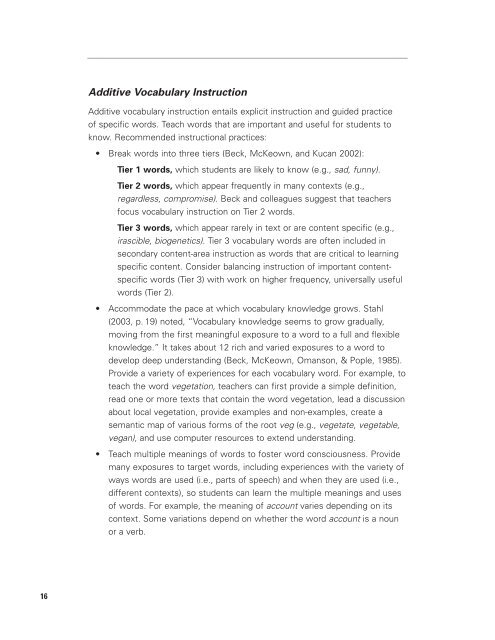Practice Brief-Struggling Readers.pdf
Practice Brief-Struggling Readers.pdf
Practice Brief-Struggling Readers.pdf
Create successful ePaper yourself
Turn your PDF publications into a flip-book with our unique Google optimized e-Paper software.
Additive Vocabulary InstructionAdditive vocabulary instruction entails explicit instruction and guided practiceof specific words. Teach words that are important and useful for students toknow. Recommended instructional practices:• Break words into three tiers (Beck, McKeown, and Kucan 2002):Tier 1 words, which students are likely to know (e.g., sad, funny).Tier 2 words, which appear frequently in many contexts (e.g.,regardless, compromise). Beck and colleagues suggest that teachersfocus vocabulary instruction on Tier 2 words.Tier 3 words, which appear rarely in text or are content specific (e.g.,irascible, biogenetics). Tier 3 vocabulary words are often included insecondary content-area instruction as words that are critical to learningspecific content. Consider balancing instruction of important contentspecificwords (Tier 3) with work on higher frequency, universally usefulwords (Tier 2).• Accommodate the pace at which vocabulary knowledge grows. Stahl(2003, p. 19) noted, “Vocabulary knowledge seems to grow gradually,moving from the first meaningful exposure to a word to a full and flexibleknowledge.” It takes about 12 rich and varied exposures to a word todevelop deep understanding (Beck, McKeown, Omanson, & Pople, 1985).Provide a variety of experiences for each vocabulary word. For example, toteach the word vegetation, teachers can first provide a simple definition,read one or more texts that contain the word vegetation, lead a discussionabout local vegetation, provide examples and non-examples, create asemantic map of various forms of the root veg (e.g., vegetate, vegetable,vegan), and use computer resources to extend understanding.• Teach multiple meanings of words to foster word consciousness. Providemany exposures to target words, including experiences with the variety ofways words are used (i.e., parts of speech) and when they are used (i.e.,different contexts), so students can learn the multiple meanings and usesof words. For example, the meaning of account varies depending on itscontext. Some variations depend on whether the word account is a nounor a verb.16


